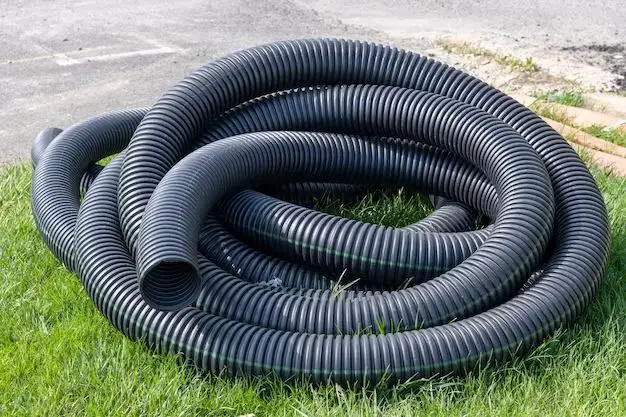When it comes to drain pipes, black is one of the most common colors you’ll see. But what exactly is a black drain pipe made of? The answer is that most modern black drain pipes are made from polyvinyl chloride, better known as PVC.
Page Contents
What is PVC?
PVC stands for polyvinyl chloride, which is a type of plastic polymer. It’s made by combining chlorine derived from salt with hydrocarbon gas derived from oil or natural gas. The resulting mixture can be shaped and hardened into pipes, fittings, and other products.
Here are some key facts about PVC:
- PVC was first created in the 1920s but wasn’t used for plumbing until the 1950s.
- It is lightweight, durable, and inexpensive compared to traditional materials like copper or cast iron.
- PVC is naturally white in color. Black PVC is created by adding carbon black pigment to the material.
- It is part of the vinyl family of plastics, along with materials like vinyl siding and flooring.
- PVC pipe is formed by heating PVC resin to make it pliable, then extruding it through a die into the correct shape.
Overall, PVC is prized in construction for its combination of low cost, light weight, durability, and ease of installation. It is used for many types of piping including drainage, sewage, potable water supply, conduit, and irrigation systems.
Benefits of PVC Drain Pipes
There are several reasons why PVC has become the material of choice for residential and commercial drain pipes:
- Durability: PVC pipes are very strong and resistant to impacts, corrosion, rotting, and scaling. They can have a lifespan of 50 years or more.
- Low Maintenance: Unlike metal pipes, PVC does not rust or corrode over time. They require little ongoing maintenance.
- Lightweight: PVC pipe weighs far less than cast iron or galvanized steel, making it easier to transport and install.
- Easy Installation: PVC pipe sections glue together simply, speeding up installation compared to traditional threaded connections.
- Noise Reduction: PVC helps deaden noise from waste water flowing through the pipes.
- Cost: PVC is one of the most affordable piping materials, keeping project costs down.
The combination of these advantages makes PVC an ideal choice for below-ground drainage applications in most homes and buildings.
Types of PVC Drain Pipes
While all black drain pipes are PVC, there are a few different types and sizes to be aware of:
1. Schedule 40
Schedule 40 is the most common PVC drain pipe type. It features medium thickness walls and pressure ratings. Schedule 40 is approved for use on drain, waste, and vent (DWV) systems.
2. Schedule 80
Schedule 80 has thicker walls than Schedule 40, giving it a higher pressure rating. It is used for low pressure applications like air ducts and condenser water pipes.
3. DWV
DWV pipe is specifically designed for drain, waste, and vent systems. It features thin walls to maximize flow capacity and reduce costs. DWV pipe is typically schedule 40 thickness.
4. Diameters
Common PVC drain pipe diameters are:
- 1.5 inches
- 2 inches
- 3 inches
- 4 inches
- 6 inches
4-inch is the standard for residential drainage. Larger diameters are used for main sewer lines.
PVC vs. ABS
ABS, or acrylonitrile butadiene styrene, is another common black plastic pipe material. So how does it compare to PVC?
| PVC | ABS |
|---|---|
| Less expensive | More expensive |
| Easier to cut and solvent weld | More difficult to work with |
| Withstands higher temperatures | Max temp 140°F |
| More rigid | More flexible |
| Widely approved for DWV systems | Approved for DWV in some areas |
Overall, PVC and ABS have similar properties, but PVC wins out in cost, temperature resistance, and code approval. That’s why it is used far more extensively than ABS for drainage applications today.
PVC Pipe Grades
PVC drain pipes are also classified by different grades that denote formulation and properties:
PVC Schedule 40
- Cellular core: lightweight, lower strength
- Solid core: heavier, higher strength
PVC Schedule 80
- Cellular core
- Solid core: most common grade
PVC DWV
- Cellular core: standard, lightweight
- Solid core: heavier, more soundproof
- Fire-rated: formulated for fire resistance
Higher schedule numbers and solid or fire-rated cores denote increased wall thickness and strength. Cellular core offers lightness and economy.
Working With PVC Pipe
Installing and working with PVC drain pipes is straightforward:
Cutting
A plastic pipe cutter, hacksaw, or power saw with the proper blade can all cut through PVC cleanly and squarely. Allow extra length for dry fitting.
Gluing
PVC pipe sections are joined using solvent cement that chemically fuses and seals the joint. Pieces should be dry fit first before applying cement.
Fittings
Elbows, tees, couplings, end caps, and other fittings are also PVC and are cemented in place like pipe sections.
Threading
While not typical, PVC can be threaded to join with metal fittings using taps and dies.
Support
Proper hangers and supports must be used to hold PVC piping in place on horizontal runs.
Conclusion
So in summary, yes – that black plastic drain pipe underneath your sink or in other drainage applications is very likely PVC. Polyvinyl chloride is relied on worldwide for its durability, reliability, and cost effectiveness. It offers homeowners and contractors an efficient, code-approved material for waste and drain systems. While other options like ABS exist, PVC remains the product of choice for its all-around utility. Next time you see black pipe, you can confidently say it’s PVC.
